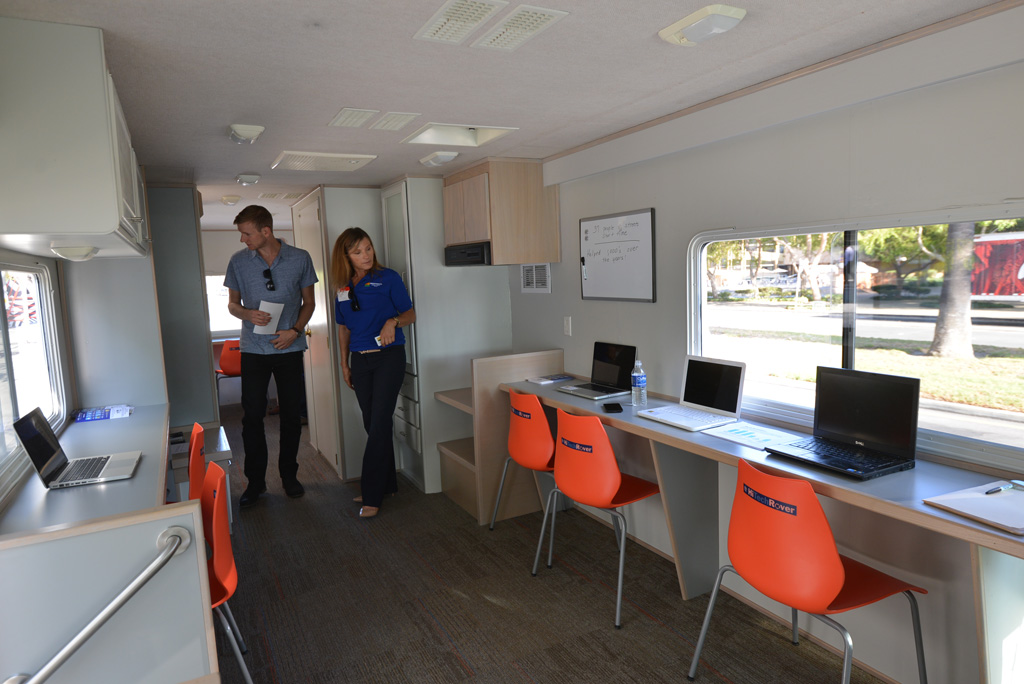Karen Addato has a reason for wanting to help the homeless, and it’s a very personal one.
“The last time I saw my brother was at the coroner’s office,” she said. “All my brother left behind in this world were four dirty, crumpled-up dollar bills.”
Stevie, an alcoholic, had been living on the streets when he died. Addato thinks he might still be alive if he’d had access to the ROVA app. The app, which currently only exists in mock-up form on Addato’s phone, is the first step in Addato’s ambitious plan to end homelessness in Silicon Valley. It’s designed to help homeless people find the nearest shower or open shelter bed or let them contact someone in an emergency.
Addato has already been working for several years to support homeless communities in Hi Tech Rovers, which are converted RVs equipped with workstations, computers, grooming supplies, and a career closet with interview-ready clothes.
“To automate this with technology, it could quadruple the amount of people we could help.”
“To automate this with technology, it just could quadruple the amount of people we could help,” Addato told Digital Trends at the Smart Cities Week conference in Santa Clara, Calif. “We see that once they leave and they disconnect, especially if they don’t have a phone, we’re losing all that momentum and effort and investment.”
Keeping the homeless who visit the Rovers connected via an app means that when a detox or shelter bed opens or a job opportunity comes through, the Rovers team can simply send a notification to their phones.
Part of the ROVA program would include handing out low-cost, low-energy-use phones that have only the app installed. To keep the phones charged, Addato has been looking into hand cranks or solar options. She’s looking for corporate sponsors to get the phones on a wireless network.
The limited functionality of the phones would hopefully dissuade thieves or the owners from trading them for money or other commodities. Instead, the user could get incentives for completing tasks, like submitting a resume for a job. In addition, a person wanting to help a homeless person could donate a meal or a Lyft ride through the app.
“We don’t want to be giving cash,” Addato said. “That’s what killed my brother.”
The phone would be tethered to them and perhaps include medical information. Addato also wants to create a missing person database, which would be voluntary. The Rover team could then coordinate linking up families with their missing loved ones. But if someone went missing, the phone could help track them.
Addato is aware that such an idea creates privacy concerns. Those who don’t want to be found in the missing-person database could opt to show up as an avatar with little or no identifiable information.
Addato didn’t come up with the idea for the Rovers or the app right away. At first, she was holding what she calls “full-scale enchilada fests” to feed groups of homeless people. For a while, she was spending $50 to $60 every Saturday handing out bag lunches — until one day she saw them thrown on the ground because a burrito cart had come.
“It was an epiphany,” she said. “I’m going to take those resources and time, and I’m going to funnel it into other things.”
As she started getting more volunteers to help with the RVs, Addato wanted a way to quickly onboard them. That’s where the idea for the app came from.
When a homeless person comes into the Rover, the staff asks them what their long-term goals are.
“It’s like they’ve never thought of it, or maybe it’s been 10 years since they thought of it,” Addato said.
From there, the volunteers create a customized list of steps for the visitor. Addato would like to input that list in the app, so the person can see their progress and get rewarded for it. The Rover’s intake form is three questions: What’s your name, do you have a phone, and what do you need? The homeless person can check a series of boxes and give as much or little information as they want.
“They might say they’re Mickey Mouse, and we’re going to run with it,” said Addato, noting that building trust takes a while. “It won’t work if they’re afraid.”
Many of the homeless who come to the Rover are looking to detox — especially toward the end of the month.
But If “Mickey” wants to start getting gift cards via the app, he’ll need to eventually provide more information. The form would be compatible with the VI-SPDAT, a triage tool for providers to assess the health and needs of homeless people and get them resources. There’s an entire manual for filling out the form, and Addato says sometimes people coming into the Rover can’t even sit through their three-question version.
Addato says many of the homeless who come to the Rover are looking to detox — especially toward the end of the month, when their subsidies run out.
“Lack of money equals motivation to recover,” she said.
This is where the most ambitious goal comes into play: building what she calls an Elevate Center, or E Center. The E-shaped building would be on two acres of land in an accessible part of the city; it could house up to 600 people in various stages of progress. One wing would be medically equipped for those detoxing, while another would be physically separated with different entrances for family housing.
“The building itself plays a role in helping people achieve steps up,” Addato said.
They might start off in a sparse room with few amenities, but as they move to different levels, they’d get more privacy and independence. The building itself would also be adaptable, expanding or contracting wings based on the number of residents.
The Rovers already have several success stories– like Dave, a former professor whose resume is four pages long.
“He said, ‘OK, I’m yours. I want off the streets,” Addato said. They got him out of his car, where he was living, and into detox. He’s been clean for a year and manages a Walgreens. It took less than a day to get a pregnant mother of three out of her car and into a motel thanks to a variety of sponsors.
Addato wants to see more collaboration from faith-based organizations, which right now tend to oversupply food and clothing, she says. Instead, they could help run data-thons, having volunteers input information about city services into the app. Addato says her goal for the Rovers and ROVA are for more homeless people to become self-sufficient, not merely fed and clothed for a night.
“It’s harder to do this than to give a sandwich,” she said. “It’s more expensive for us to do this, but we want to be effective.”





